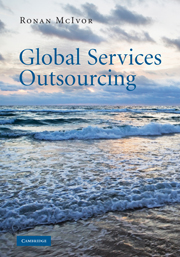Book contents
- Frontmatter
- Contents
- List of figures
- List of tables
- List of illustrations
- Acknowledgements
- 1 Introduction
- 2 Global services outsourcing overview
- 3 Making the services outsourcing decision
- 4 Location and sourcing model choice in global services outsourcing
- 5 Managing global services outsourcing arrangements
- 6 Creating shared services arrangements
- 7 Services outsourcing and performance management
- 8 Services outsourcing and the spin-off arrangement
- 9 Learning from failure and strategies for recovery in business process outsourcing
- 10 Conclusion
- Glossary
- Index
- References
6 - Creating shared services arrangements
Published online by Cambridge University Press: 05 June 2012
- Frontmatter
- Contents
- List of figures
- List of tables
- List of illustrations
- Acknowledgements
- 1 Introduction
- 2 Global services outsourcing overview
- 3 Making the services outsourcing decision
- 4 Location and sourcing model choice in global services outsourcing
- 5 Managing global services outsourcing arrangements
- 6 Creating shared services arrangements
- 7 Services outsourcing and performance management
- 8 Services outsourcing and the spin-off arrangement
- 9 Learning from failure and strategies for recovery in business process outsourcing
- 10 Conclusion
- Glossary
- Index
- References
Summary
Introduction
Shared services arrangements involve consolidating and standardising common tasks associated with a business function in different parts of an organisation into a single services centre. These services are then provided by the service centre to other parts of the organisation. Shared services centres can be owned and operated by the organisation, or outsourced to independent vendors. Shared services have been increasing in prominence in both the private and public sectors, and encompass a range of back-office functions such as finance and accounting (F&A), human resources (HR), procurement, information technology (IT) and facilities management. Although many of the services provided by these functions are not visible to customers, they have a major impact on service quality, particularly when they are not performing properly. Indeed, senior executives often express dissatisfaction with service levels, despite the considerable expenditure involved in running these functions. Shared services have been viewed as a strategy for achieving both efficiencies and improved service performance levels, as organisations have strived to reduce costs and enhance performance in these back-office functions.
Benefits of shared services
When effectively implemented, shared services arrangements offer a number of benefits.
Cost savings. Shared services arrangements allow organisations to reduce costs through process standardisation and economies of scale. Standardisation of processes in non-core functions such as HR, F&A and procurement reduces duplication across the organisation. Economies of scale are achieved through combining processes previously carried out independently.
- Type
- Chapter
- Information
- Global Services Outsourcing , pp. 149 - 181Publisher: Cambridge University PressPrint publication year: 2010



